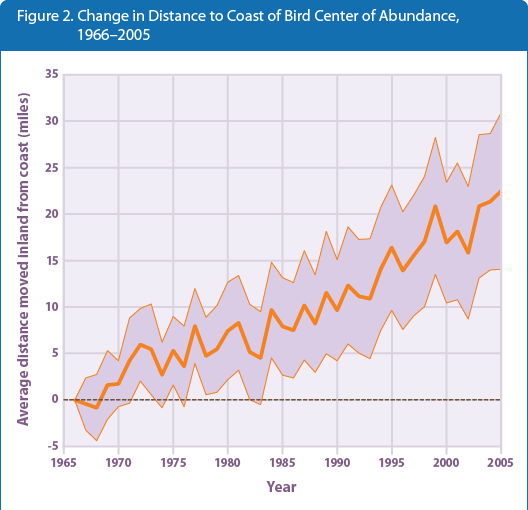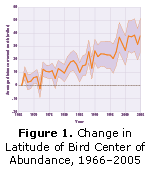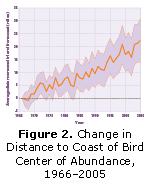Climate Change
Climate Change Indicators in the United States

This figure shows annual change in latitude of bird center of abundance for 305 widespread bird species in North America from 1966 to 2005. Each winter is represented by the year in which it began (for example, winter 2005–2006 is shown as 2005). The shaded band shows the likely range of values, based on the number of measurements collected and the precision of the methods used.
Data source: National Audubon Society, 2009 3

This figure shows annual change in distance to the coast of bird center of abundance for 305 widespread bird species in North America from 1966 to 2005. Each winter is represented by the year in which it began (for example, winter 2005–2006 is shown as 2005). The shaded band shows the likely range of values, based on the number of measurements collected and the precision of the methods used.
Data source: National Audubon Society, 2009 4
Key Points
- Among 305 widespread North American bird species, the average mid-December to early January center of abundance moved northward between 1966 and 2005. The average species shifted northward by 35 miles during this period (see Figure 1). Trends in center of abundance are closely related to winter temperatures. 1
- On average, bird species have also moved their wintering grounds farther from the coast since the 1960s (see Figure 2).
- Some species have moved farther than others. Of the 305 species studied, 177 (58 percent) have shifted their wintering grounds significantly to the north since the 1960s, but some others have not moved at all. A few species have moved northward by as much as 200 to 400 miles. 2
Background
Changes in climate can affect ecosystems by influencing animal behavior and distribution. Birds are a particularly good indicator of environmental change for several reasons:
- Each species of bird has adapted to certain habitat types, food sources, and temperature ranges. In addition, the timing of certain events in their life cycles—such as migration and reproduction—is driven by cues from the environment. For example, many North American birds follow a regular seasonal migration pattern, moving north to feed and breed in the summer, then moving south to spend the winter in warmer areas. Changing conditions can influence the distribution of both migratory and nonmigratory birds as well as the timing of important life-cycle events.
- Birds are easy to identify and count, and thus there is a wealth of scientific knowledge about their distribution and abundance. People have kept detailed records of bird observations for more than a century.
- There are many different species of birds living in a variety of habitats, including water birds, coastal birds, and land birds. If a change in habitats or habits is seen across a range of bird types, it suggests that a common force might be contributing to that change.
Temperature and precipitation patterns are changing across the United States (see the U.S. and Global Temperature indicator and the U.S. and Global Precipitation indicator). Some bird species can adapt to generally warmer temperatures by changing where they live—for example, by migrating further north in the summer but not as far south in the winter, or by shifting inland as winter temperature extremes grow less severe. Nonmigratory species might shift as well, expanding into newly suitable habitats while moving out of areas that become less suitable. Other types of birds might not adapt to changing conditions, and might experience a population decline as a result. Climate change can also alter the timing of events that are based on temperature cues, such as migration and breeding (especially egg-laying).
About the Indicator
This indicator looks at the "center of abundance" of 305 widespread North American bird species over a 40-year period. The center of abundance is a point on the map that represents the middle of each species' distribution. If a whole population of birds were to shift generally northward, one would see the center of abundance shift northward as well.
For year-to-year consistency, this indicator uses observations from the National Audubon Society's Christmas Bird Count, which takes place every year in early winter. The Christmas Bird Count is a long-running citizen science program in which individuals are organized by the National Audubon Society, Bird Studies Canada, local Audubon chapters, and other bird clubs to identify and count bird species. The data presented in this indicator were collected from more than 2,000 locations throughout the United States and parts of Canada. At each location, skilled observers follow a standard counting procedure to estimate the number of birds within a 15-mile diameter "count circle" over a 24-hour period. Study methods remain generally consistent from year to year. Data produced by the Christmas Bird Count go through several levels of review before Audubon scientists analyze the final data, which have been used to support a wide variety of peer-reviewed studies.
Indicator Confidence
Many factors can influence bird ranges, including food availability, habitat alteration, and interactions with other species. As a result, some of the birds covered in this indicator might have moved north for reasons other than changing temperatures. This indicator also does not show how responses to climate change vary among different types of birds. For example, a more detailed National Audubon Society analysis found large differences between coastal birds, grassland birds, and birds adapted to feeders, which all have varying abilities to adapt to temperature changes. 5
Some data variations can be caused by differences between count circles, such as inconsistent level of effort by volunteer observers, but these differences are carefully corrected in Audubon's statistical analysis.
Data Sources
Bird center of abundance data were collected by the annual Christmas Bird Count organized by the National Audubon Society and Bird Studies Canada. Recent and historical Christmas Bird Count data are available at: www.audubon.org/Bird/cbc. Data for this indicator were analyzed by the National Audubon Society in 2009 6 and are available at: www.audubon.org/bird/bacc/ index.html.
Indicator Documentation
- Download related technical information PDF (5 pp, 40K)




